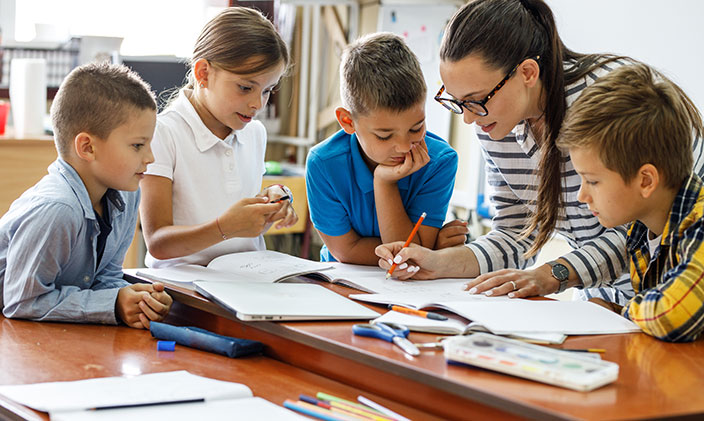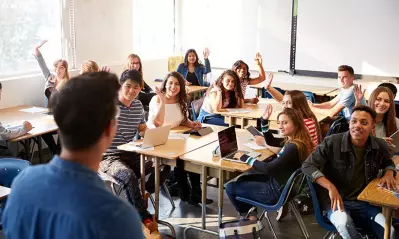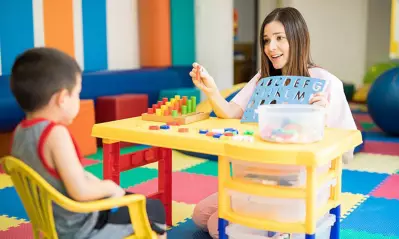Building strong relationships with students

Written by Michael Feder

Reviewed by Kathryn Uhles, MIS, MSP, Dean, College of Business and IT

Many educators invest their time in obtaining the right qualifications and learning the various educational theories. Some focus on honing the qualities that make a good teacher, including guilding relationships with students.
The importance of positive teacher–student relationships
A positive approach to building relationships with students can greatly impact a successful learning experience. They can improve student self-confidence, academic performance and mutual respect between the two parties.
A positive relationship often has open communication where teachers actively listen to their students and encouragingly provide feedback and guidance. Positive relationships also let students feel secure so they can speak up in class and reach out when needed. All these results in more-engaged learners who are willing to take risks while exploring new ideas.
Ultimately, these relationships help foster an environment of trust where learning can occur without fear, judgment or failure.
How to develop relationships with students
Every student is different, but the following strategies can foster strong teacher–student relationships in most classrooms.
1. Show your passion
As a teacher, showing enthusiasm and passion for your subject is essential. Not only will this help you engage with students, but it is also vital for fostering an atmosphere of learning and exploration. Enthusiasm motivates students to learn, while passion shows them how the lessons have relevance and purpose.
A few ways to show enthusiasm in the classroom are to:
- Offer creative activities
- Engage with students’ opinions
- Provide examples that are relevant to them
By meeting your students where they are and adapting your curriculum to reflect their interests, you can create an environment of motivation in the classroom. Seeing your students’ enthusiasm is one of the many benefits you can expect as a teacher. while building relationships with students.
2. Treat everyone with respect
It’s essential to treat each student with respect and recognize their individual needs. This means being patient, understanding and open to hearing different perspectives. Respectful teacher–student relationships are based on trust and communication — both involve actively listening to students as they share their thoughts and feelings while providing ample opportunity to voice concerns or feedback.
When students feel respected and heard, it can transform their relationship with school. It can dramatically improve their school experience, including reducing the number of suspensions and drop-out rates. They are also more likely to participate in class discussions, take risks exploring new concepts and be open to feedback. This can also lead to a stronger bond that benefits teachers and students alike.
To show respect and create a welcoming classroom :
- Take time to listen to what students have to say
- Balance teacher-centered lectures with group discussions
- Give each student undivided attention when needed
- Provide positive reinforcement and meaningful feedback
3. Highlight the good more than the bad
Rewarding good behavior and achievements is a great way to encourage learning while building relationships with students. It can also be a more effective way of reinforcing positive behaviors when compared to simply punishing the bad.
By drawing attention to what students are doing right and praising their successes, teachers can create an environment where students feel valued and supported, as well as motivated to continue striving for success. Students can then also recognize their progress and build a sense of accomplishment. A few ways to reward good behavior are:
- Verbally acknowledging accomplishments
- Offering incentives such as extra credit or a special activity
- Creating a bulletin board that celebrates student successes
- Notifying families about progress and achievements, not just potential problems
With support from inside and outside the classroom, students can feel empowered and motivated to reach their goals.
4. Learn more about your students
Getting to know your students on a deeper level lets you tailor your teaching methods and activities to fit their individual needs — and build stronger relationships in the process.
To get started, try having regular one-on-one conversations with students or hosting group activities that encourage collaboration and discussion. Additionally, you can invite students to share aspects of their personal lives, such as hobbies, passions or family stories. Relating to any of their experiences can help your students feel more comfortable and connected while underscoring your commitment to their success.
5. Make time for one-on-one communication
Building relationships with students shouldn’t be limited to classroom instruction. Many students need a teacher who is willing to listen and give support they need. While it’s hard to fit every student into your busy schedule, making time for one-on-one communication is necessary. This could include:
- Meeting with students before or after class to discuss assignments
- Giving them extra help during their free periods
- Setting aside a few minutes daily to check in and ask how they’re doing
It may not sound like much, but these actions can make a huge difference in building a strong bond and fostering communication. Even taking this approach with small groups of two or three students can help you get to know them personally and build trust.
6. Let students make choices
Providing students autonomy and the freedom to make their own choices can help them develop vital problem-solving skills. It can also help instill a sense of responsibility, ownership and independence in your students.
To create an atmosphere where students feel comfortable making decisions, try the following:
- Develop open-ended questions that allow room for creativity
- Create an activity or assignment requiring students to collaborate and problem-solve
- Allow students to choose their projects or assignments
- Be flexible with classroom rules allowing for a certain degree of freedom within the structure
Inviting students to voice their opinions and take ownership of their learning allows them to take an active role in their education.
7. Admit mistakes and learn from them
Mistakes are a natural part of the learning process, so acknowledging them and using them as an opportunity to grow can help students gain confidence. When teachers and students make mistakes, it’s best to approach them with understanding. This could involve:
- Acknowledging your own mistakes when you make them
- Creating a safe space for students to share mistakes without judgment
- Having conversations about how to learn from mistakes and using them as a chance to grow is a great way of building relationships with students.
Seeing mistakes as opportunities for growth can help your students develop resilience and hone their problem-solving skills.
8. Welcome feedback and change
Students may have valid suggestions or critiques of your teaching methods and activities. Showing that you value their input can help them feel more heard and engaged in the learning process.
Encourage students to provide honest feedback through:
- Creating surveys or polls with open-ended questions
- Inviting student feedback on lesson plans and activities
- Allowing students to share their thoughts after each class
A student’s voice is a powerful tool that can help shape the learning environment for the better, especially when the feedback is honestly offered and openly received. As a teacher, you don’t have to give credence to every idea offered, but you do have to approach each idea with an open mind and a willingness to change.
9. Lead as a role model
Leading by example is one of the most important ways of building relationships with students. Show your students you care about their success and well-being by:
- Being a role model for positive behavior, such as being respectful and showing kindness
- Practicing self-care and encouraging your students to do the same
- Showing an interest in building relationships with each student
While not every moment of teacher leadership will be successful or enjoyable, leading by example can help students understand the importance of positive behavior.
10. Say hello and goodbye every day
A simple “good morning” or “have a great day” can go a long way. Taking the time to greet your students daily can help create an atmosphere of warmth, respect and friendship in the classroom. Sometimes kids need to know someone cares.
Greeting your students each day could involve:
- Making eye contact as you pass out materials or take attendance
- Welcoming them with a smile and “Good morning, everyone!”
- Saying goodbye with an encouraging phrase such as, “I hope you have a great day!”
These small but meaningful gestures can make a big difference in how your students feel about themselves and their learning experience.
Building relationships with students is vital for creating a supportive classroom environment.
So, take the time to get to know your students, listen to what they have to say and be open to learning from them as much as possible. The result may just be a successful classroom and lifelong learning mindset for teacher and student alike.
Earn a degree in education to learn more about building relationships with students
Building relationships with students is vital for creating a supportive classroom environment. Whether you are taking the first step in your journey toward a career in education or looking to expand your existing knowledge and skill set, University of Phoenix offers a variety of degree and certificate options. These include:
- Bachelor of Science in Education/Early Childhood Education — This program teaches curriculum planning, instructional practice, student engagement and many other valuable educational skills.
- Bachelor of Science in Education/Elementary Education — If you’re eager to learn skills geared toward teaching at the elementary school level, this elementary education degree program helps build a solid foundation in teaching and leadership, learning strategies and more.

ABOUT THE AUTHOR
A graduate of Johns Hopkins University and its Writing Seminars program and winner of the Stephen A. Dixon Literary Prize, Michael Feder brings an eye for detail and a passion for research to every article he writes. His academic and professional background includes experience in marketing, content development, script writing and SEO. Today, he works as a multimedia specialist at University of Phoenix where he covers a variety of topics ranging from healthcare to IT.

ABOUT THE REVIEWER
As dean of the University of Phoenix College of Education, Pamela Roggeman has spent over a decade in higher education teacher preparation in both the public and private sector. Her experience has included national partnerships that help to advance thought leadership in the field of education. Dr. Roggeman also serves as the President of the Arizona Educational Foundation’s Board of Directors.
This article has been vetted by University of Phoenix's editorial advisory committee.
Read more about our editorial process.


